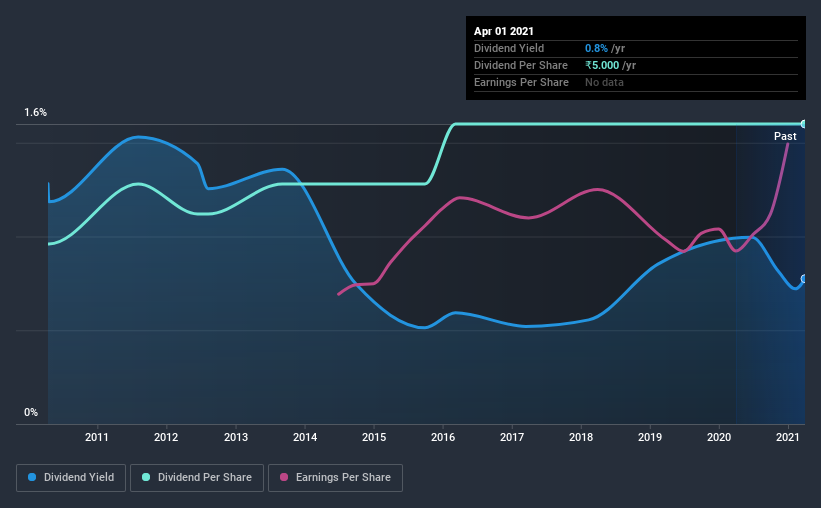Read This Before Buying The Sandesh Limited (NSE:SANDESH) For Its Dividend
Could The Sandesh Limited (NSE:SANDESH) be an attractive dividend share to own for the long haul? Investors are often drawn to strong companies with the idea of reinvesting the dividends. Yet sometimes, investors buy a stock for its dividend and lose money because the share price falls by more than they earned in dividend payments.
A 0.8% yield is nothing to get excited about, but investors probably think the long payment history suggests Sandesh has some staying power. Some simple analysis can reduce the risk of holding Sandesh for its dividend, and we'll focus on the most important aspects below.
Explore this interactive chart for our latest analysis on Sandesh!

Payout ratios
Dividends are usually paid out of company earnings. If a company is paying more than it earns, then the dividend might become unsustainable - hardly an ideal situation. As a result, we should always investigate whether a company can afford its dividend, measured as a percentage of a company's net income after tax. In the last year, Sandesh paid out 3.8% of its profit as dividends. We like this low payout ratio, because it implies the dividend is well covered and leaves ample opportunity for reinvestment.
We also measure dividends paid against a company's levered free cash flow, to see if enough cash was generated to cover the dividend. Last year, Sandesh paid a dividend while reporting negative free cash flow. While there may be an explanation, we think this behaviour is generally not sustainable.
While the above analysis focuses on dividends relative to a company's earnings, we do note Sandesh's strong net cash position, which will let it pay larger dividends for a time, should it choose.
We update our data on Sandesh every 24 hours, so you can always get our latest analysis of its financial health, here.
Dividend Volatility
From the perspective of an income investor who wants to earn dividends for many years, there is not much point buying a stock if its dividend is regularly cut or is not reliable. Sandesh has been paying dividends for a long time, but for the purpose of this analysis, we only examine the past 10 years of payments. The dividend has been stable over the past 10 years, which is great. We think this could suggest some resilience to the business and its dividends. During the past 10-year period, the first annual payment was ₹3.0 in 2011, compared to ₹5.0 last year. This works out to be a compound annual growth rate (CAGR) of approximately 5.2% a year over that time.
Companies like this, growing their dividend at a decent rate, can be very valuable over the long term, if the rate of growth can be maintained.
Dividend Growth Potential
While dividend payments have been relatively reliable, it would also be nice if earnings per share (EPS) were growing, as this is essential to maintaining the dividend's purchasing power over the long term. Sandesh has grown its earnings per share at 5.4% per annum over the past five years. A low payout ratio and strong historical earnings growth suggests Sandesh has been effectively reinvesting in its business. We think this generally bodes well for its dividend prospects.
Conclusion
Dividend investors should always want to know if a) a company's dividends are affordable, b) if there is a track record of consistent payments, and c) if the dividend is capable of growing. Sandesh has a low payout ratio, which we like, although it paid out virtually all of its generated cash. Second, earnings growth has been mediocre, but at least the dividends have been relatively stable. Ultimately, Sandesh comes up short on our dividend analysis. It's not that we think it is a bad company - just that there are likely more appealing dividend prospects out there on this analysis.
Companies possessing a stable dividend policy will likely enjoy greater investor interest than those suffering from a more inconsistent approach. However, there are other things to consider for investors when analysing stock performance. For example, we've identified 2 warning signs for Sandesh (1 can't be ignored!) that you should be aware of before investing.
Looking for more high-yielding dividend ideas? Try our curated list of dividend stocks with a yield above 3%.
If you’re looking to trade Sandesh, open an account with the lowest-cost* platform trusted by professionals, Interactive Brokers. Their clients from over 200 countries and territories trade stocks, options, futures, forex, bonds and funds worldwide from a single integrated account. Promoted
New: Manage All Your Stock Portfolios in One Place
We've created the ultimate portfolio companion for stock investors, and it's free.
• Connect an unlimited number of Portfolios and see your total in one currency
• Be alerted to new Warning Signs or Risks via email or mobile
• Track the Fair Value of your stocks
This article by Simply Wall St is general in nature. It does not constitute a recommendation to buy or sell any stock, and does not take account of your objectives, or your financial situation. We aim to bring you long-term focused analysis driven by fundamental data. Note that our analysis may not factor in the latest price-sensitive company announcements or qualitative material. Simply Wall St has no position in any stocks mentioned.
*Interactive Brokers Rated Lowest Cost Broker by StockBrokers.com Annual Online Review 2020
Have feedback on this article? Concerned about the content? Get in touch with us directly. Alternatively, email editorial-team (at) simplywallst.com.
About NSEI:SANDESH
Sandesh
Together with its subsidiary, Sandesh Digital Private Limited, engages in the editing, printing, and publishing of newspapers and periodicals in India.
Flawless balance sheet established dividend payer.
Similar Companies
Market Insights
Community Narratives



